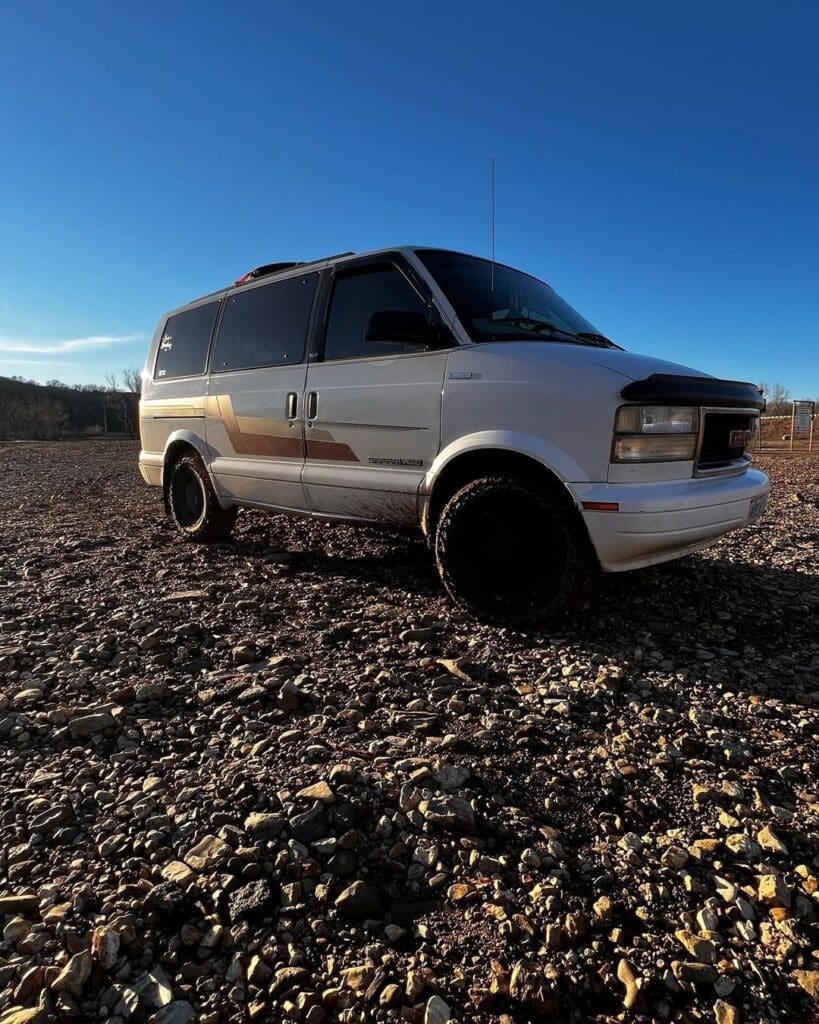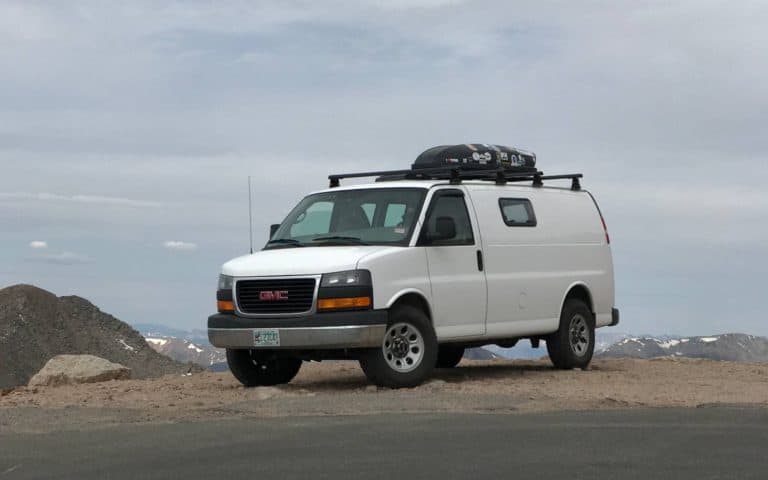AWD vans are becoming a hugely popular choice for van life. In this article, we’ll discuss the pros and cons of AWD and 4×4 vans for your camper van conversion, how they work, and whether you should get one. You’ll also find a complete list of vans available in AWD or 4×4 in the US market, including some aftermarket conversions.
AWD vans give drivers peace of mind in slick wintry conditions. All-wheel drive and four-wheel drive vans are popular with skiers and snowboarders. Anyone who chases snow on purpose should consider a drivetrain that provides more traction.
AWD and 4WD also allow you to go further on sand, snow, and rough dirt roads without getting stuck. But AWD vans also cost more and get worse gas mileage than their two-wheel drive counterparts. Furthermore, some popular vans are onlyavailable in two-wheel drive; even aftermarket 4×4 converters won’t touch them. So if AWD is important to you, you must know what to look for.
AWD vs. 4×4: What’s the Difference?
What’s the difference between all-wheel drive and four-wheel drive? Both systems operate on similar principles. Both send power to both axles, unlike two-wheel drive vehicles that power one or the other. (Incidentally, two-wheel drive vehicles are typically designated either RWD—rear-wheel drive—or FWD—front-wheel drive—depending on which axle gets the power.)
Getting power to all four tires is a game-changer in challenging driving conditions. If the front or rear wheels get stuck in the mud or start spinning on slick ice, you’re still in control of the other two.
But there’s a catch: AWD and 4WD both increase the vehicle’s cost and decrease its fuel economy.
AWD Vans
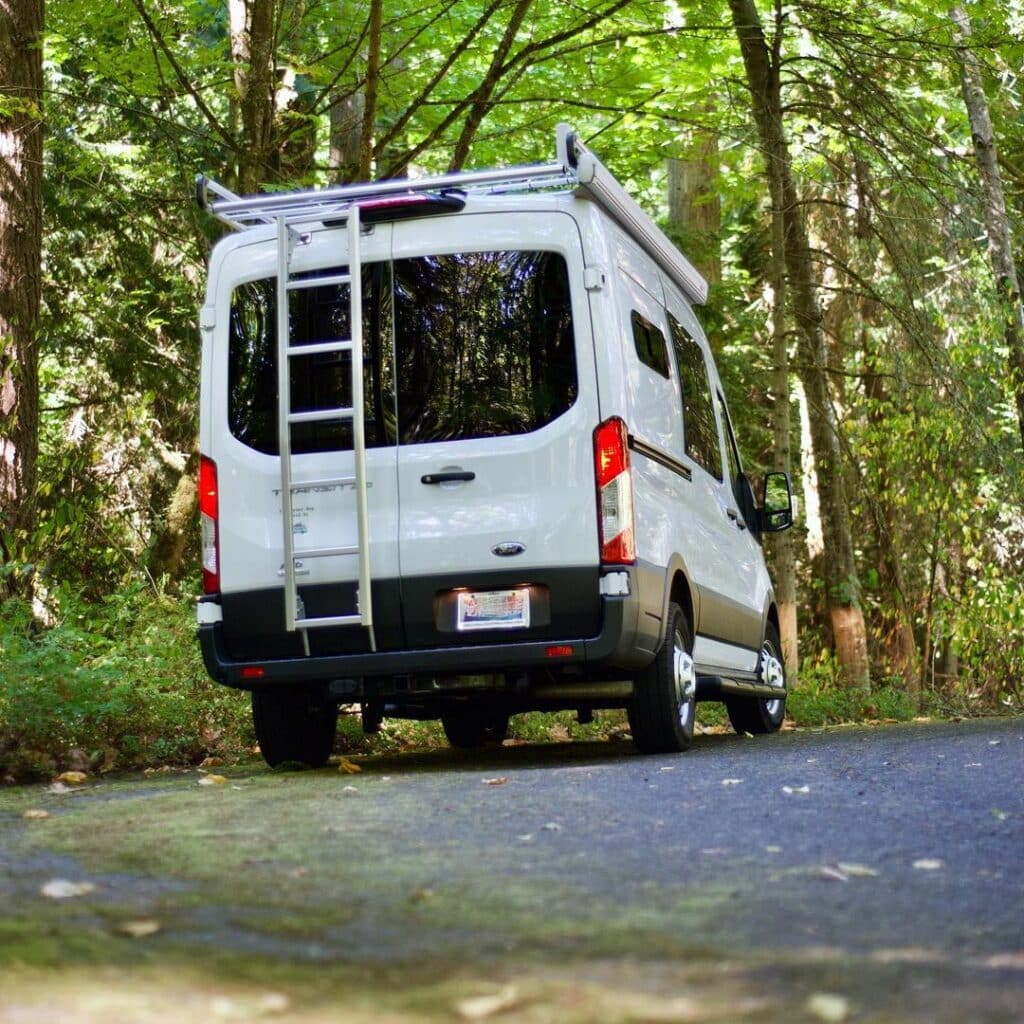
All-wheel drive vehicles have sophisticated computers that apportion power to all four wheels individually. The vehicle computer can automatically change the torque to a given wheel if it senses slippage.
Full-Time vs. Part-Time AWD
In vehicles with “full-time” AWD, all-wheel drive is always engaged while driving. In contrast, vehicles with “part-time” AWD default to two-wheel drive most of the time and only engage the other two when extra traction is needed.
The Details
All-wheel drive shines on pavement, especially if there’s snow on the ground. Because AWD engages automatically, it’s a great option at highway speeds when quick reactions to changing road conditions are essential. AWD vans also handle well: the driving experience isn’t that different from a standard 2WD.
AWD systems aren’t quite as heavy as 4WD, either. Although AWD vans are less efficient than 2WD vehicles, they have better fuel economy than 4WD vans.
However, AWD isn’t as rugged as 4×4 and won’t do as well with heavy off-roading.
4×4 Vans
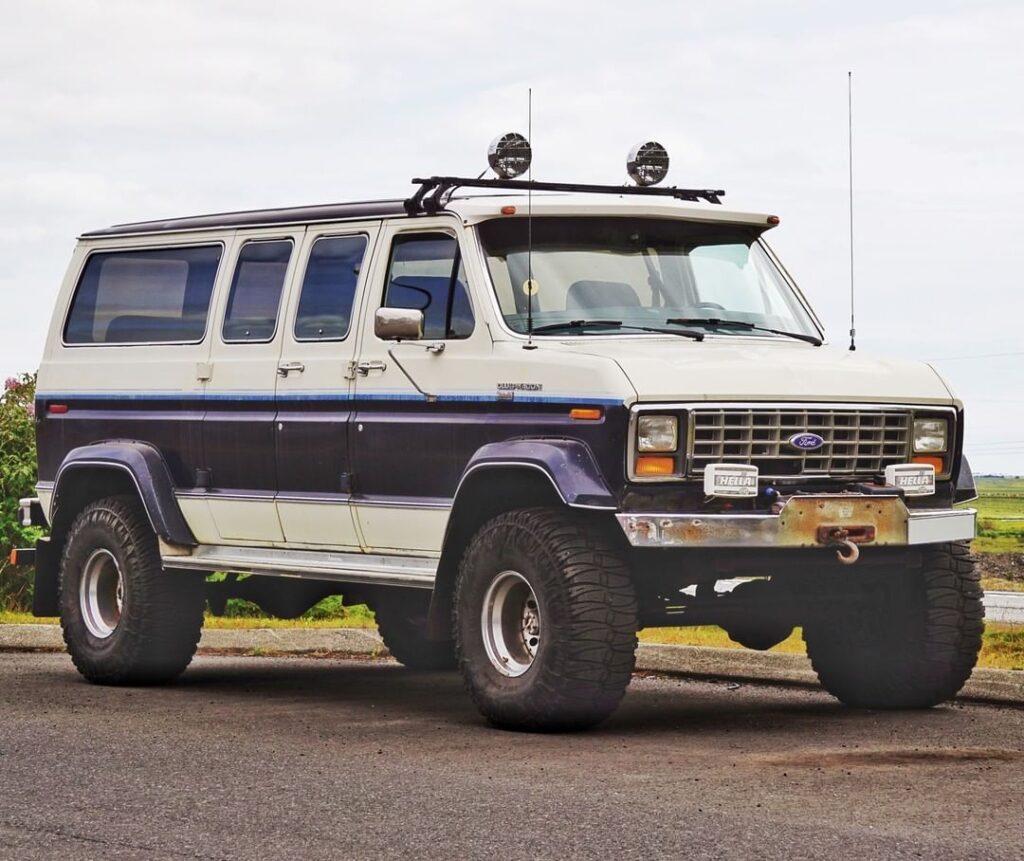
Four-wheel drive—also known as 4WD or 4×4—vehicles mechanically link the vehicle’s two axles together so that both get an equal amount of power. 4×4 systems don’t have the precision adjustment of computerized AWD, but they’re much more capable for rugged off-roading. 4WD typically has to be engaged manually.
4H vs. 4L
Most 4WD autos come equipped with both four-high (4H) and four-low (4L) options. 4L provides more torque and is useful for getting unstuck from mud, snow, sand, or gravel, but drivers should try to stay below ten mph.
Meanwhile, 4H can be taken up to 55mph but doesn’t provide as much torque as 4L. 4H is more like AWD regarding the level of traction provided and functionality at highway speeds. However, it’s more limiting on pavement because it lacks AWD’s precision adjustment and rapid reaction time.
The Details
When you switch on 4WD, you may find that your van is harder to control and that turning is a challenge. Also, 4×4 systems weigh more than AWD, so vans with 4×4 tend to have worse gas mileage (even when 4WD isn’t engaged). Still, there’s nothing better than four-wheel drive for navigating steep terrain or loose snow, mud, sand, or gravel. If you plan to do serious off-roading or want to explore steep, loose, rocky dirt roads, this is the way to go.
A Complete List of AWD and 4×4 Vans in the US
Now that you know the difference between four-wheel drive and all-wheel drive, let’s look at all the full-size vans and minivans you can buy in the US with either.
The following list includes some models that are no longer in production (but that you can still find on the used market). Note that none of these models come standard with AWD or 4×4: you must upgrade from the base model to get these benefits.
Some 2WD vans can be upfitted to 4×4 with an aftermarket conversion kit. We’ll discuss that further down, so keep reading.
1. Ford Transit
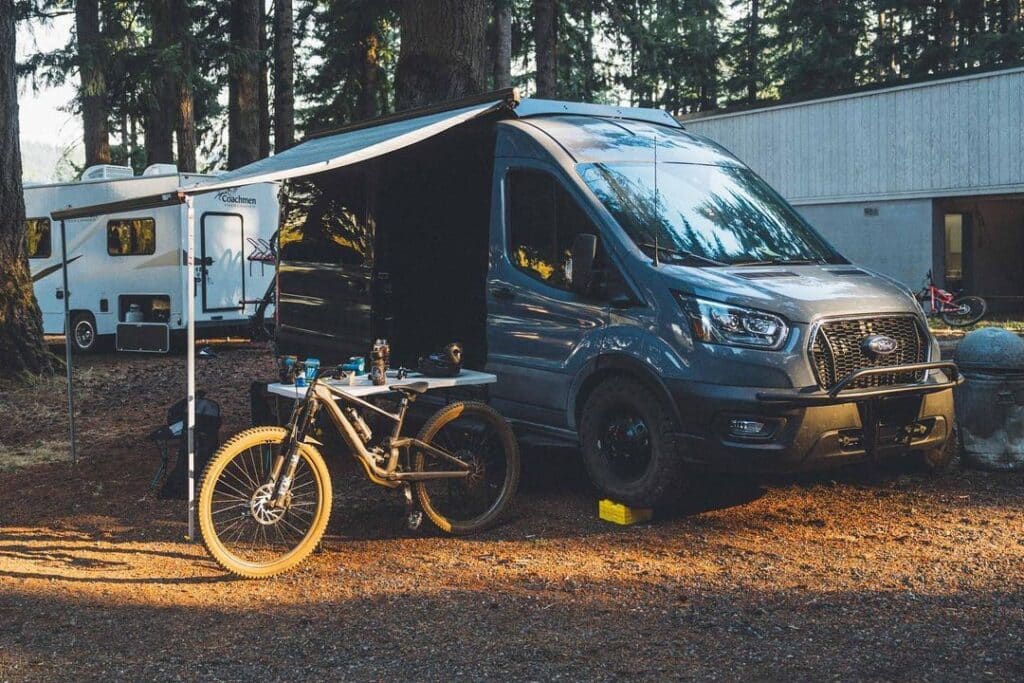
Model Years: 2020 – present
First manufactured in North America in 2015, the Ford Transit came out with an AWD option in 2020. And in 2023, Ford will release the Transit Trail, an upfitted vehicle geared toward offroad van lifers. The Transit Trail will come standard with all-wheel drive, higher clearance than regular Transits, and offroading features like splash guards, wheel cladding, and a skid plate front bumper.
With the Ram Promaster and the Mercedes Sprinter, the Ford Transit is among the three most popular modern cargo vans for conversion. However, many consider the Transit more reliable than the Promaster and more affordable than the imported Sprinter. It’s a great choice for van lifers looking for a newer cargo vehicle with many possible configurations.
The Ford Transit is the only cargo van currently in production in the US that offers factory-installed AWD, though that’s about to change.
Read More: 10 Badass Ford Transit Van Conversions to Inspire Your Van Build
2. AWD Mercedes Sprinter

Model Years: 2023 –
The Sprinter van is a Mercedes chassis, but you’ll sometimes see it badged and sold as a Dodge because of import duties.
Until recently, the Sprinter was the only currently produced van that offered factory 4×4. However, Mercedes is discontinuing 4×4 models as of 2023 and replacing them with all-wheel drive. Like the previous 4×4 version, only diesel Sprinters will be available as AWD vans. So if you’re a gasoline aficionado, you’re out of luck.
The posh Sprinter has long been the top-shelf choice for van lifers looking to spare no expense on their builds—and a 4WD or AWD upgrade from the base model makes it even more luxe. The AWD Sprinter should drop in 2023, so it will be a while before any of these bad boys trickle down to the used vehicle market.
Read More: 13 Unique Sprinter Van Conversions for Van Life Inspiration
3. Chevy Express / GMC Savana
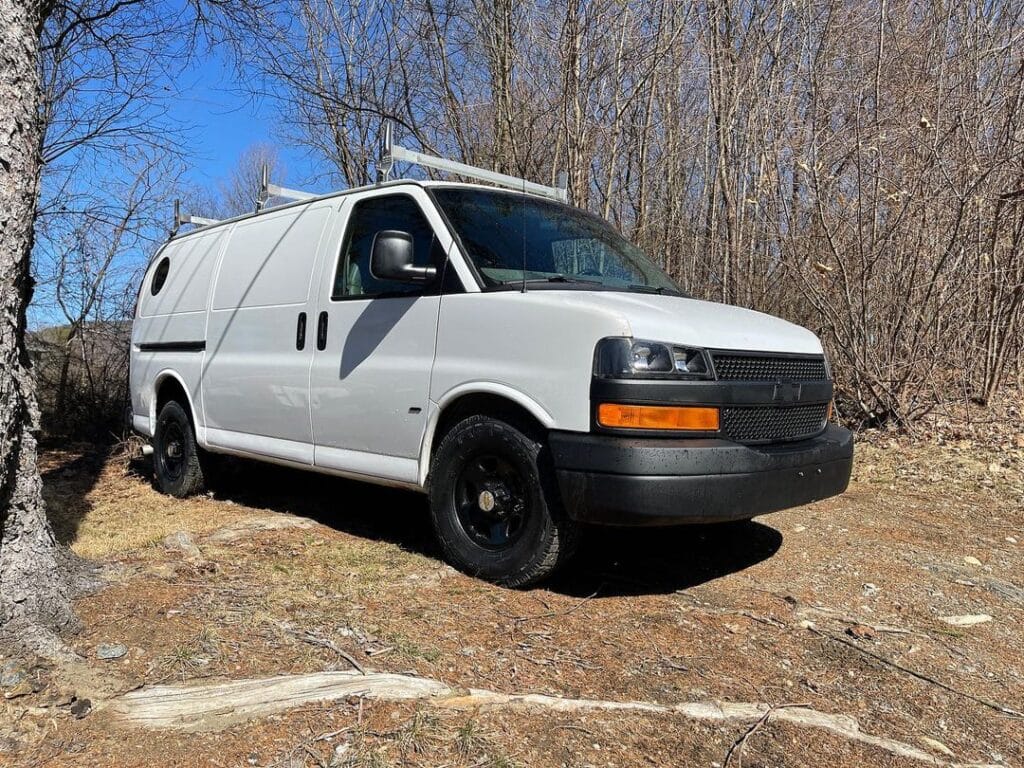
Model Years: 2003 – 2014
The Chevy Express and the GMC Savana are identical vehicles sold under two different labels. Although the Express/Savana is still in production today, only the old 1500-series had AWD, and that was discontinued in 2014.
Fortunately, the Chevy Express (or GMC Savana) is one of the most popular candidates for 4×4 conversion. So if you have a 2WD Express/Savana of any model year, you still have a chance to upgrade to 4×4 after the fact. Otherwise, plenty of old 1500-series AWD vans are still kicking around the used market.
Read More: 10 Chevy Express Van Builds You Need to See
4. 4×4 Mercedes Sprinter
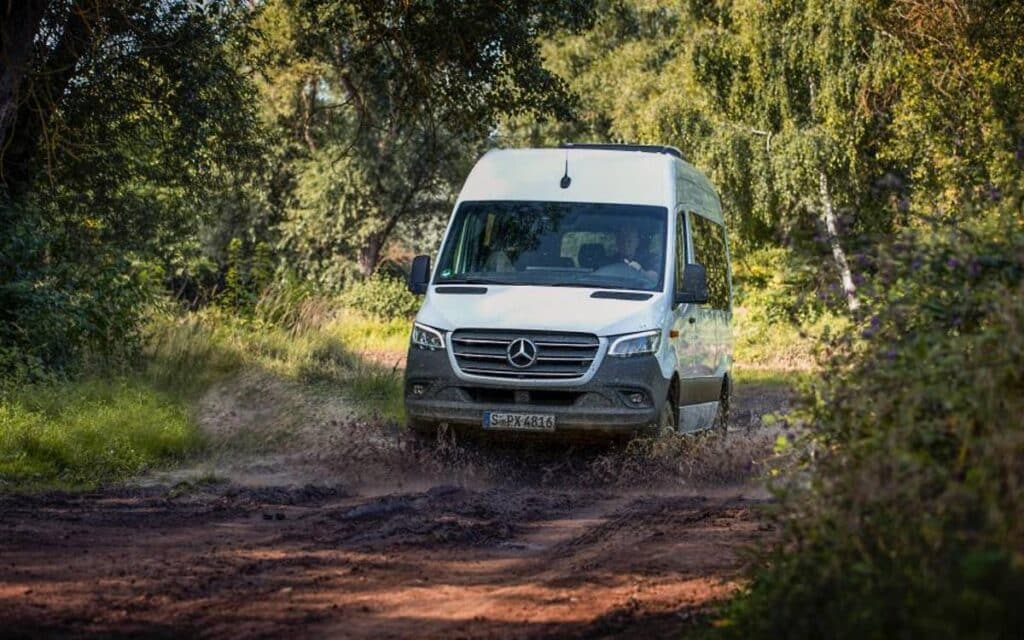
Model Years: 2015 – 2022
The Mercedes Sprinter was, until recently, the only currently produced van manufactured as a 4×4 van. Mercedes announced earlier this year that it’s discontinuing the beloved 4×4 Sprinter and replacing it with an AWD system.
Still, there are many 4×4 Sprinter van conversions on the roads already. In addition to DIY conversions, upfitters like Sportsmobile use the 4×4 Sprinter as a base. If you keep your eye on the used van market, you may be able to snag a 4×4 van that way. Just note that only diesel Sprinters ever came in 4×4.
Read More: Compare Sprinter vs Transit vs Promaster for Van Life
5. Toyota HiAce / Mitsubishi Delica
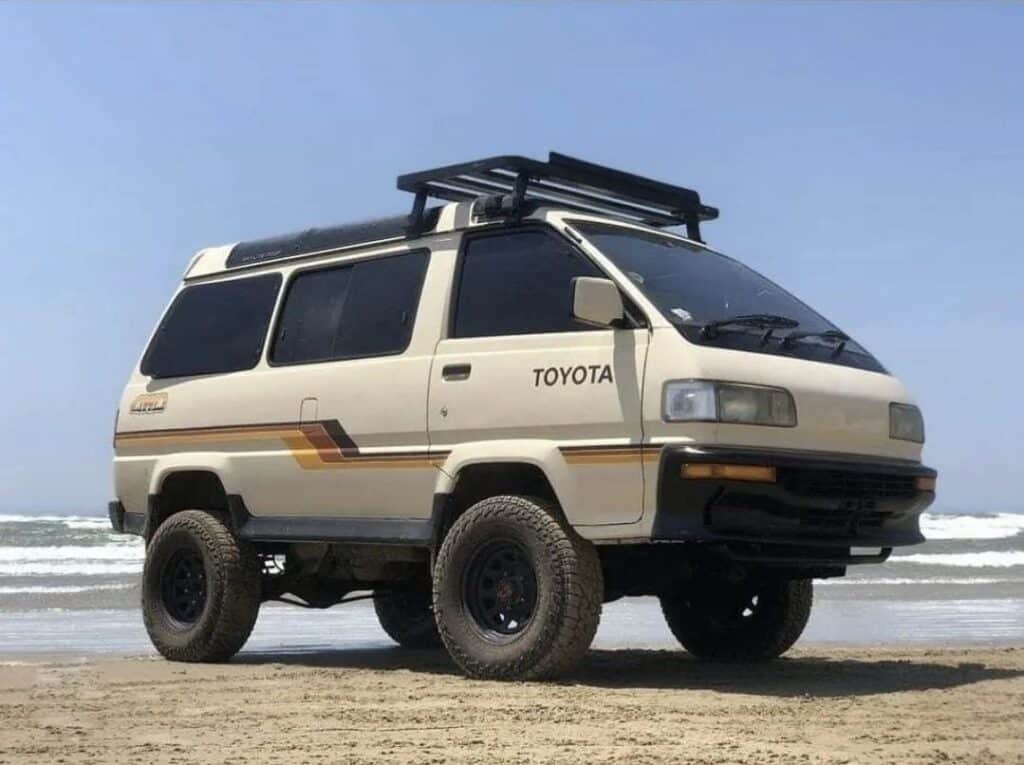
Model Years: 1970s and 80s – 1998
These two imports were never produced in the United States. Although both are still in production in Japan and elsewhere, US law prevents importing vehicles less than 25 years old. Vintage HiAces and Delicas from the 90s have finally aged out of this policy and begun to trickle into the US used van market in recent years.
The Toyota HiAce and Mitsubishi Delica are somewhat similar in design and appearance. Some feel the Delica was better suited to proper off-roading than the HiAce. On the other hand, others value Toyota’s reputation for building reliable autos.
Van lifers love these two models for their charisma, compactness, and capable 4×4. Although both vans are considered highly reliable, US buyers should anticipate maintenance issues since whatever they buy will be at least 25 years old.
Read More: 24 Best Small Camper Vans for a Van Conversion
6. Volkswagen Vanagon Synchro
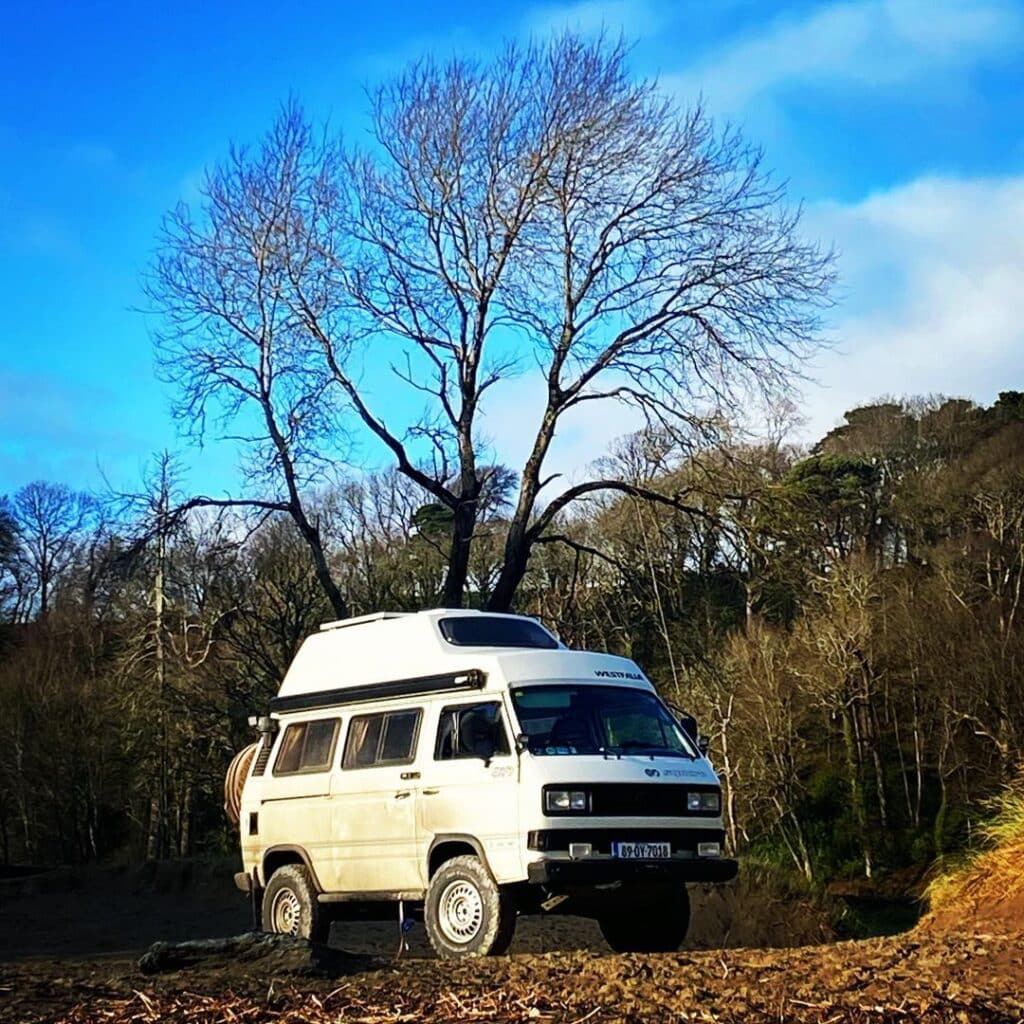
Model Years: 1986-1991
VW sold its vans under the name “Vanagon” from 1980 to 1991. For the last five years (1986 to 1991), VW offered the 4WD Vanagon Syncro, a four-wheel drive van available in passenger and campervan models. After 1991, VW replaced the Vanagon line with the VW Eurovan and phased out 4WD permanently.
Vanagons have a lot of charisma. However, word on the street (according to GoWesty) is that the Vanagon Syncro is quite expensive to buy and maintain. Many view it as a collector’s item rather than a practical purchase. Curious, I did a quick search and found Westfalia Syncro conversions listing for as much as $70,000—so the stories appear genuine.
7. Toyota Sienna
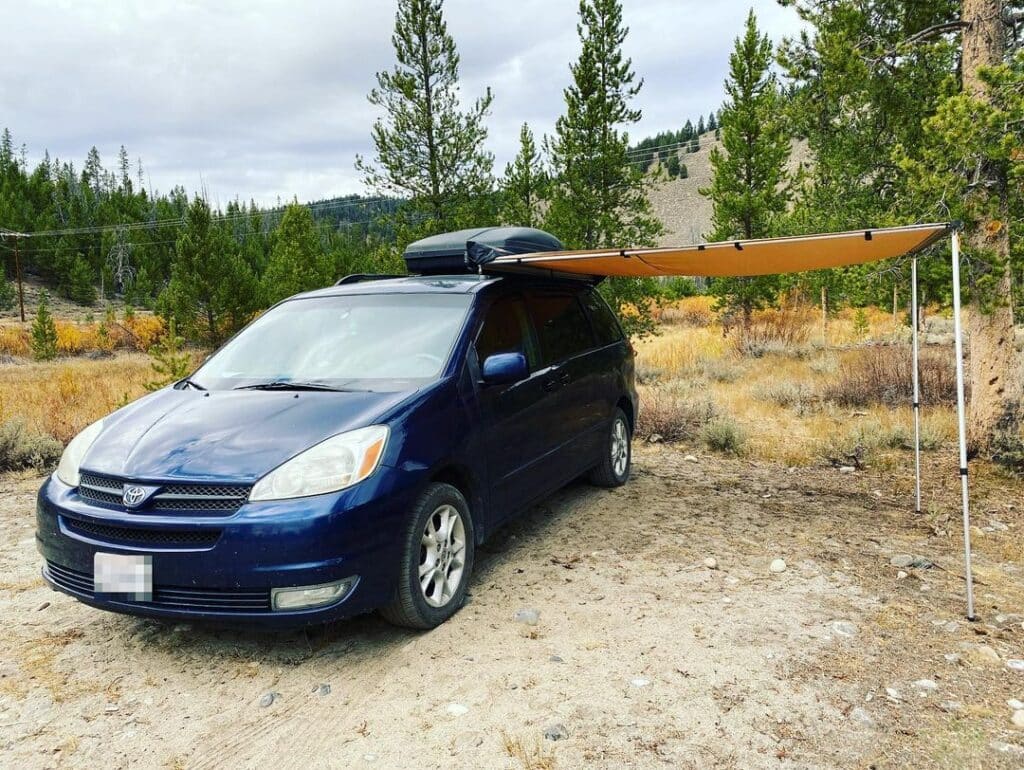
Model Years: 2011 –
The Toyota Sienna is one of the most popular minivans to convert into a camper. Well-maintained Siennas can crank hundreds of thousands of miles and hang onto their resale value for years. Until recently, the Sienna was the only AWD minivan in production on the US market. Toyota became the only company to offer a hybrid AWD option with its introduction of the hybrid Sienna in 2020.
Because of their high resale value, the Toyota Sienna isn’t the most budget-friendly if you’re just looking at the up-front purchase price. And because the Sienna is a Japanese vehicle, parts and maintenance are a bit more expensive than those from US manufacturers.
However, these vans are capable and low maintenance. If you take care of it, a Toyota Sienna can last many years. Minivans are also cheaper than full-size vans. Conversions cost less because there isn’t enough space to accommodate all the bells and whistles of a cargo van conversion. And there is a robust market for lift kits and overlanding accessories built just for the Toyota Sienna, so it’s possible to turn this humble minivan into a badass off road van.
Read More: 11 Awesome Toyota Sienna Camper Conversions
8. Chrysler Pacifica
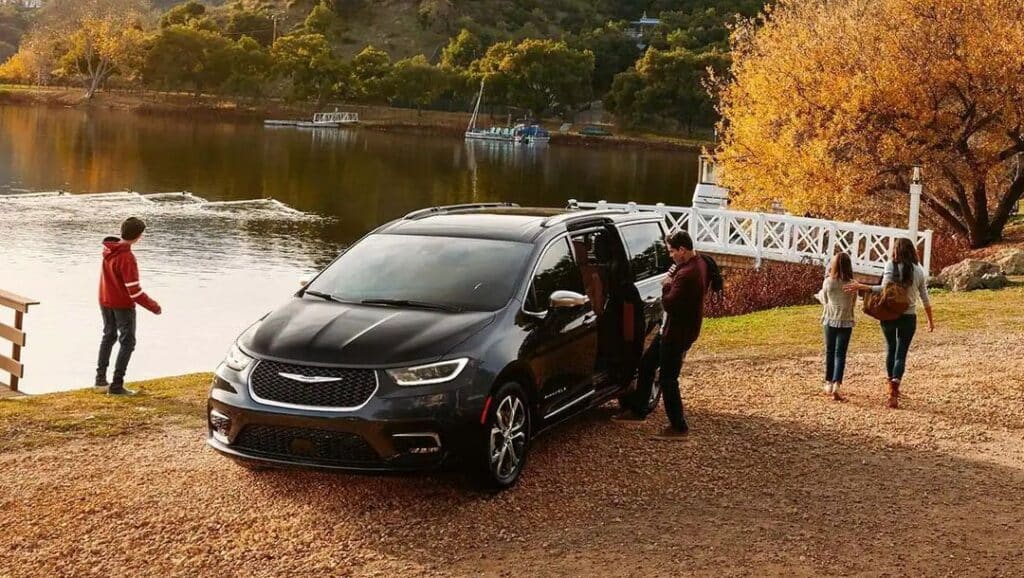
Model Years: 2020 –
The Chrysler Pacifica (formerly the Town and Country) introduced all-wheel drive to its lineup in 2020. With the Toyota Sienna, the Pacifica is one of only two modern minivans available in AWD. The Pacifica is reportedly not that different from the Sienna in price, size, or performance. The Toyota Sienna has under an inch more ground clearance than the Chrysler Pacifica (6.1 vs. 5.4, respectively). You never know. Those extra 0.7 could make all the difference on a rocky road.
More significantly, you can fold both the second and third seating rows in the Chrysler Pacifica into the floor compared to just the third row of the Sienna. This feature could be a game-changer for DIYers looking for a hassle-free conversion that doesn’t involve ripping seats out.
9. Chevy Astro / GMC Safari
Model Years: 1990 – 2005
Like the Chevy Express and GMC Savana, the Chevy Astro and GMC Safari are the same van rebadged and sold under two different names.
Although Astros/Safaris have the boxy shape of a traditional cargo van, they’re sized like minivans. DIYers who want a more compact camper will find the Astro easier to work with than traditional minivans, which are universally allergic to right angles and built out for passengers in the back.
The Chevy Astro is kind of like a mini Chevy Express. It has a 111-inch wheelbase, in contrast to the Express’s 135-inch wheelbase, and the roof is about 10 inches lower.
The Astro/Safari is a popular, budget-friendly choice for van life. It was available in AWD from 1990 until the model was discontinued in 2005. However, there are plenty of them floating around the used van market for a reasonable price.
Popular Vans That Do NOT Have Factory 4×4 or All-Wheel Drive
Buying a van with factory 4×4 or AWD isn’t the only way to get badass off road capability. The vans below are commonly converted to 4×4.
Ford Econoline
The Ford E-series, also known as the Econoline, was never available as an AWD van. However, Econolines are among the most popular candidates for aftermarket 4×4 conversion, which is lucky since this workhorse is one of the most commonly converted campervans in the US.
School buses and ambulances also often have E-series chassis. Although Ford discontinued E-series vans in 2015, the used van market is awash in affordable Econolines.
Read More: 10 Ford Econoline Van Conversions to Make You Drool
Ram Promaster
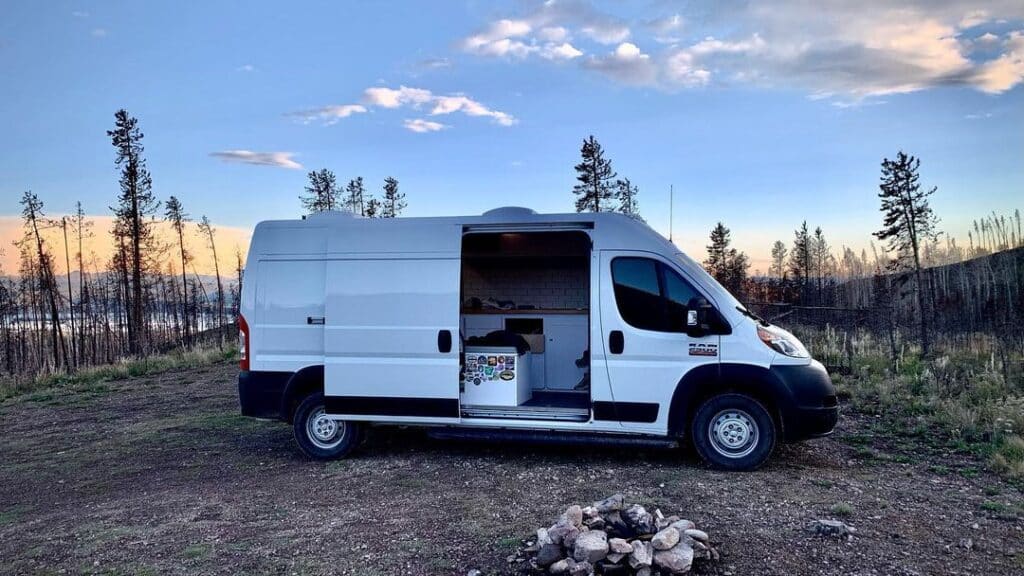
Upfitters love the Promaster for its square cargo hold, which makes designing a camper conversion relatively easy. With the Ford Transit and the Mercedes Sprinter, it’s one of the most popular cargo vans currently produced in the US.
However, the Promaster also has the distinction of being among the only front-wheel drive (FWD) vans in the US, which makes aftermarket 4WD conversion difficult and impractical. FWD is why you never see 4×4-capable Promasters on the road. Popular 4×4 conversion companies won’t work with them. Ram doesn’t make a factory AWD Promaster either, so Ram van devotees are out of luck on the 4×4 front.
Read More: 15 Awesome Ram Promaster Conversions to Inspire Your Build
Nissan NV
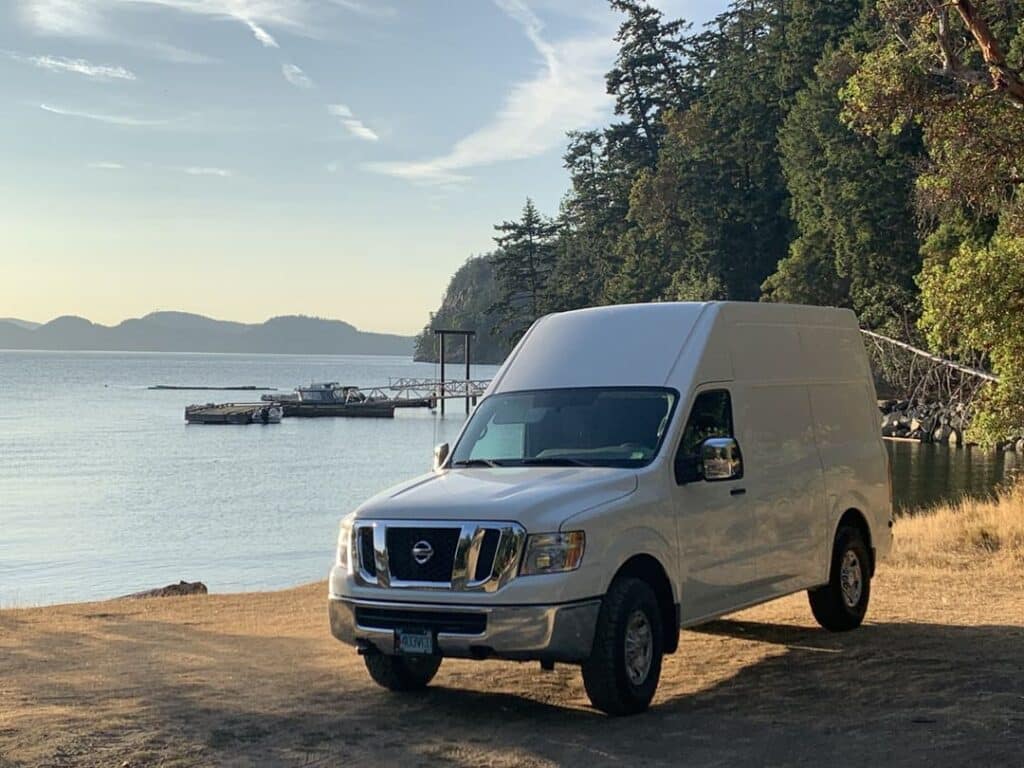
Nissan discontinued the NV in 2021. Though never the most popular model for a campervan, a steady stream of NV conversions has kept the model relevant.
You can find plenty of used NVs, though none with AWD or 4×4, as Nissan never offered it. Fortunately, some aftermarket 4×4 upfitters will work with the NV, so you can still convert your van into an off-road chariot if you want to.
Honda Odyssey
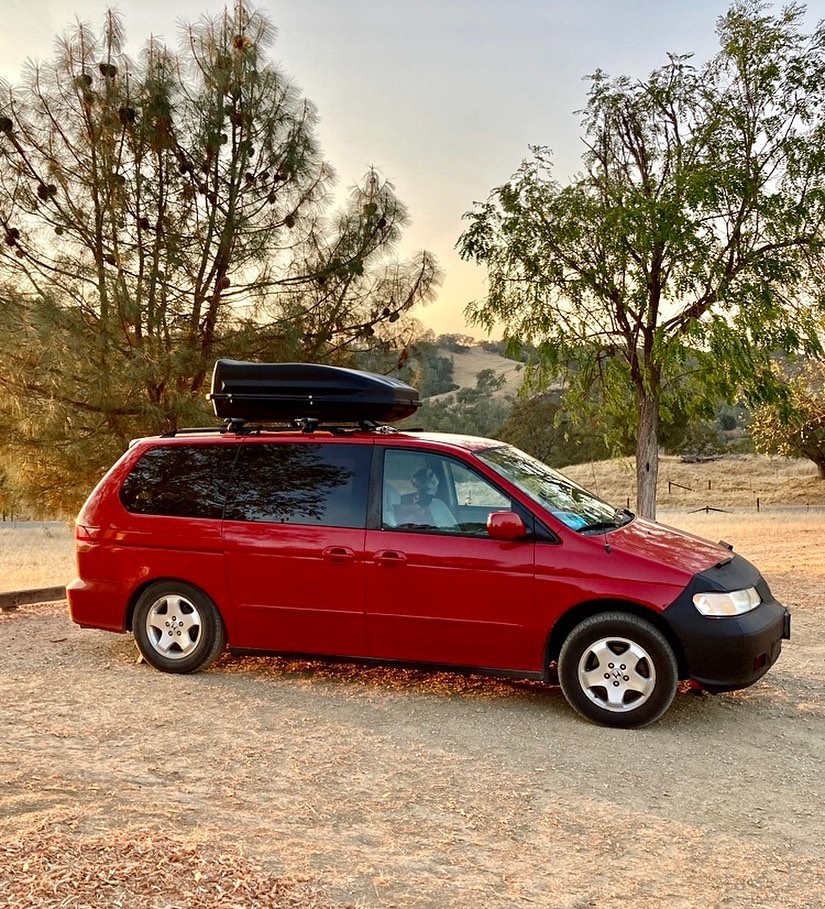
With the Sienna and Pacifica, the reliable Honda Odyssey is among the most popular minivan camper models. However, it isn’t available in AWD. I’ve yet to see an upfitter offer minivan 4×4 conversions, though the idea is fun.
Read More: 15 Honda Odyssey Camper Conversions That Are Great for Van Life
Truck Campers: 4×4 and AWD Campervan Alternative
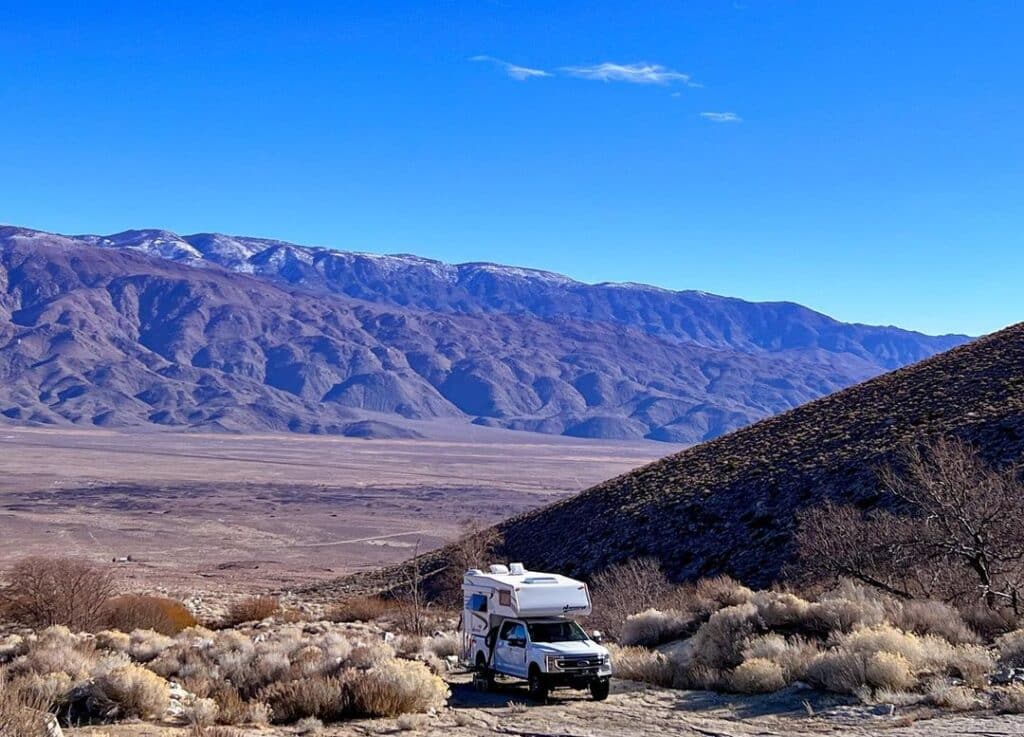
As you can see from the list above, there are many AWD vans available today. But AWD vans are expensive, and used models can be relatively hard to find. And even with AWD or 4×4, at the end of the day, a campervan is still a boxy, top-heavy lump that can be difficult to navigate over rough terrain.
If you aim to do a lot of off-roading, winter driving, or boondocking down remote roads, consider a truck camper as an alternative to an AWD van. Most pickup trucks can be converted to tiny homes on wheels with a simple truck bed cap or a more elaborate slide-in camper.
Sourcing a used pickup camper may be cheaper and easier than sourcing an AWD or 4×4 van. Four-wheel drive is a common feature in pickup trucks, so you won’t face a scavenger hunt to find this feature. And trucks are more agile and have higher clearance than vans, making them better suited to off-road adventures.
Aftermarket 4×4 Conversion
Four-wheel drive works by mechanically linking the front and rear axles with a bar, sharing power equally between the four tires. It’s relatively straightforward to convert a 2WD van to 4WD. Aftermarket AWD conversion isn’t a thing.
Aftermarket 4×4 conversion adds weight to your build, reducing fuel economy by several miles per gallon. It’s also expensive. You can purchase the kit and install it yourself, but even that costs thousands of dollars and requires technical know-how. If you pay a professional upfitter to install it, the extra cost will run you tens of thousands of dollars.
In contrast, a new van with factory-installed 4×4 will cost an extra $5,000 to $7,000 over its 2WD equivalent. So it may be somewhat more economical to buy a vehicle with factory-installed AWD or 4×4. But if 4×4 is that important to you, know that aftermarket is an option.
Aftermarket Companies
Some of the biggest names in aftermarket 4×4 conversion include Quigley, Ujoint, and Advanced 4×4. You’ll have to take the vehicle to them, so it’s worth searching to see if there are any companies near your home base (if you have one).
Most companies will only work with a few specific makes and models. Typical candidates include the Ford E-Series, GM vans (Chevy Express, Chevy Astro, GMC Savana, and GMC Safari), and the Ford Transit. Some companies will also work with the Nissan NV.
Other Features to Look for in an Off-Road-Worthy Van
All-wheel or four-wheel drive will help you to navigate adverse road conditions. Still, these systems are only one piece of the puzzle. The following upgrades will help make your vehicle off-road-worthy. These upgrades don’t accomplish the same thing as AWD. Instead, they complement your AWD or 4×4 system to help your van stand up to rough terrain.
Clearance
A sturdy 4×4 van is nothing without adequate clearance. You’ll feel pretty badass crawling up steep mountain roads in your incredible AWD van until you drive over a too-tall rock and rip out your oil pan.
While most automakers design 4×4 vans with adequate ground clearance in mind, many AWD vans sit lower than the eight-inch minimum clearance off-roaders typically seek. For instance, the AWD Ford Transit sits 5.2 to 5.7 inches off the ground, compared to the 4×4 Mercedes Sprinter with 8.1 inches of clearance.
If you want to take your low-clearance AWD van down rocky roads, consider purchasing an aftermarket lift kit to give yourself a few extra inches.
Suspension
Your vehicle suspension is a system of shocks and springs that dampen vibration for a smoother ride. The equation here is simple: a beefier suspension + a lighter build = a smoother ride.
This probably isn’t news to you, but back roads are pretty bumpy. Good suspension is vital if you’re looking into 4×4 and AWD vans because you plan to explore rugged terrain. Consider an aftermarket suspension upgrade if you plan on taking bumpy roads.
Tires
Beefy all-terrain tires are better on rough (or non-existent) roads than standard tires. All-terrain tires have deeper tread and reinforced sidewalls. They may be somewhat broader than stock tires. Note that all-terrain tires tend to make more noise at highway speeds and will reduce your gas mileage.
If you’re looking into an AWD van because you plan to drive on snowy and icy roads in winter, consider swapping your regular tires for snow tires. For extra-slick conditions, you should also keep snow chains on hand for added traction.
Build Details
It’s incredibly distracting to bump down a rough path with your dishes and silverware rattling up a storm and bins falling off the shelves. Plan your conversion with heavy vibration in mind.
- Use furniture latches, bungee cords, strong magnets, or similar to secure cabinet doors and items on shelves.
- Use foam, recycled packing sleeves, or towels to protect glassware/silverware and reduce rattling.
- Opt for plastic, silicone, or bamboo kitchenware rather than glass, metal, or ceramic to reduce noise and breakage.
- Make straight cuts when woodworking and/or leave some allowance between joins to reduce squeaking.
- Batten down the hatches before driving: secure loose or hanging items so they don’t slide or bang (you should do this even before driving on pavement).
Knowing How To Drive
Throwing money at fancy 4×4 vans, lift kits, and more traction is no substitute for common sense and driving skills. Driving on icy roads is tricky, and rough roads can be even more challenging. It takes practice and confidence to do it well.
When should you ease off the gas, and when should you gun it? Which rocks are too tall for your oil pan, and which areas are too steep for your engine to overcome? Is that giant, thick mud puddle a no-go? A driver needs experience, good judgment, and presence of mind to answer these questions.
4×4 or AWD vans can help you to stay in control, but don’t let one of these systems lull you into a false sense of security. You still need to be good at driving in challenging conditions, which only comes with practice.
The bottom line is to be cautious. Scout rough roads before you drive them, and when in doubt, don’t go that way.

